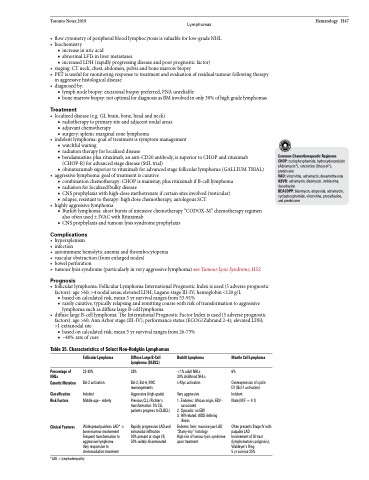Page 587 - TNFlipTest
P. 587
Toronto Notes 2019 Lymphomas
• flowcytometryofperipheralbloodlymphocytosisisvaluableforlow-gradeNHL
• biochemistry
■ increase in uric acid
■ abnormal LFTs in liver metastases
■ increased LDH (rapidly progressing disease and poor prognostic factor)
• staging:CTneck,chest,abdomen,pelvisandbonemarrowbiopsy
• PETisusefulformonitoringresponsetotreatmentandevaluationofresidualtumourfollowingtherapy
in aggressive histological disease
• diagnosedby:
■ lymph node biopsy: excisional biopsy preferred, FNA unreliable
■ bonemarrowbiopsy:notoptimalfordiagnosisasBMinvolvedinonly30%ofhighgradelymphomas
Treatment
• localizeddisease(e.g.GI,brain,bone,headandneck)
■ radiotherapy to primary site and adjacent nodal areas ■ adjuvant chemotherapy
■ surgery: splenic marginal zone lymphoma
• indolentlymphoma:goaloftreatmentissymptommanagement
■ watchful waiting
■ radiation therapy for localized disease
■ bendamustine plus rituximab, an anti-CD20 antibody, is superior to CHOP and rituximab
(CHOP-R) for advanced stage disease (StIL trial)
■ obinutuzumab superior to rituximab for advanced stage follicular lymphoma (GALLIUM TRIAL)
• aggressivelymphoma:goaloftreatmentiscurative
■ combination chemotherapy: CHOP is mainstay, plus rituximab if B-cell lymphoma ■ radiation for localized/bulky disease
■ CNS prophylaxis with high-dose methotrexate if certain sites involved (testicular) ■ relapse, resistant to therapy: high dose chemotherapy, autologous SCT
• highlyaggressivelymphoma
■ Burkitt lymphoma: short bursts of intensive chemotherapy “CODOX-M” chemotherapy regimen
also often used ± IVAC with Rituximab
■ CNS prophylaxis and tumour lysis syndrome prophylaxis
Complications
• hypersplenism
• infection
• autoimmunehemolyticanemiaandthrombocytopenia
• vascularobstruction(fromenlargednodes)
• bowelperforation
• tumourlysissyndrome(particularlyinveryaggressivelymphoma)seeTumourLysisSyndrome,H52
Prognosis
• follicularlymphoma:FollicularLymphomaInternationalPrognosticIndexisused(5adverseprognostic factors): age >60; >4 nodal areas; elevated LDH; Lugano stage III-IV; hemoglobin <120 g/L
■ based on calculated risk, mean 5 yr survival ranges from 53-91%
■ rarely curative, typically relapsing and remitting course with risk of transformation to aggressive
lymphoma such as diffuse large B-cell lymphoma
• diffuselargeB-celllymphoma:TheInternationalPrognosticFactorIndexisused(5adverseprognostic
factors): age >60; Ann Arbor stage (III-IV); performance status (ECOG/Zubrand 2-4); elevated LDH; >1 extranodal site
Hematology H47
■ based on calculated risk, mean 5 yr survival ranges from 26-73% ■ ~40% rate of cure
Table 35. Characteristics of Select Non-Hodgkin Lymphomas
Common Chemotherapeutic Regimens CHOP: cyclophosphamide, hydroxydoxorubicin (Adriamycin®), vincristine (Oncovin®), prednisone
VAD: vincristine, adriamycin, dexamethasone ABVD: adriamycin, bleomycin, vinblastine, dacarbazine
BEACOPP: bleomycin, etoposide, adriamycin, cyclophosphamide, vincristine, procarbazine, and prednisone
Percentage of NHLs
Genetic Mutation
Classification Risk Factors
Clinical Features
Follicular Lymphoma
22-30%
Bcl-2 activation
Indolent
Middle-age – elderly
Widespread painless LAD* ± bone marrow involvement Frequent transformation to aggressive lymphoma
Very responsive to chemoradiation treatment
Diffuse Large B-Cell Lymphoma (DLBCL)
33%
Bcl-2, Bcl-6, MYC rearrangements
Aggressive (high-grade)
Previous CLL (Richter’s transformation: 5% CLL patients progress to DLBCL)
Rapidly progressive LAD and extranodal infiltration
50% present at stage I/II, 50% widely disseminated
Burkitt Lymphoma
<1% adult NHLs 30% childhood NHLs
c-Myc activation
Very aggressive
1. Endemic: African origin, EBV- associated
2. Sporadic: no EBV
3. HIV-related: AIDS-defining
illness
Endemic form: massive jaw LAD “Starry-sky” histology
High risk of tumour lysis syndrome upon treatment
Mantle Cell Lymphoma
6%
Overexpression of cyclin D1 (Bcl-1 activation)
Indolent
Male (M:F = 4:1)
Often presents Stage IV with palpable LAD
Involvement of GI tract (lymphomatosis polyposis), Waldeyer’s Ring
5 yr survival 25%
*LAD = lymphadenopathy


